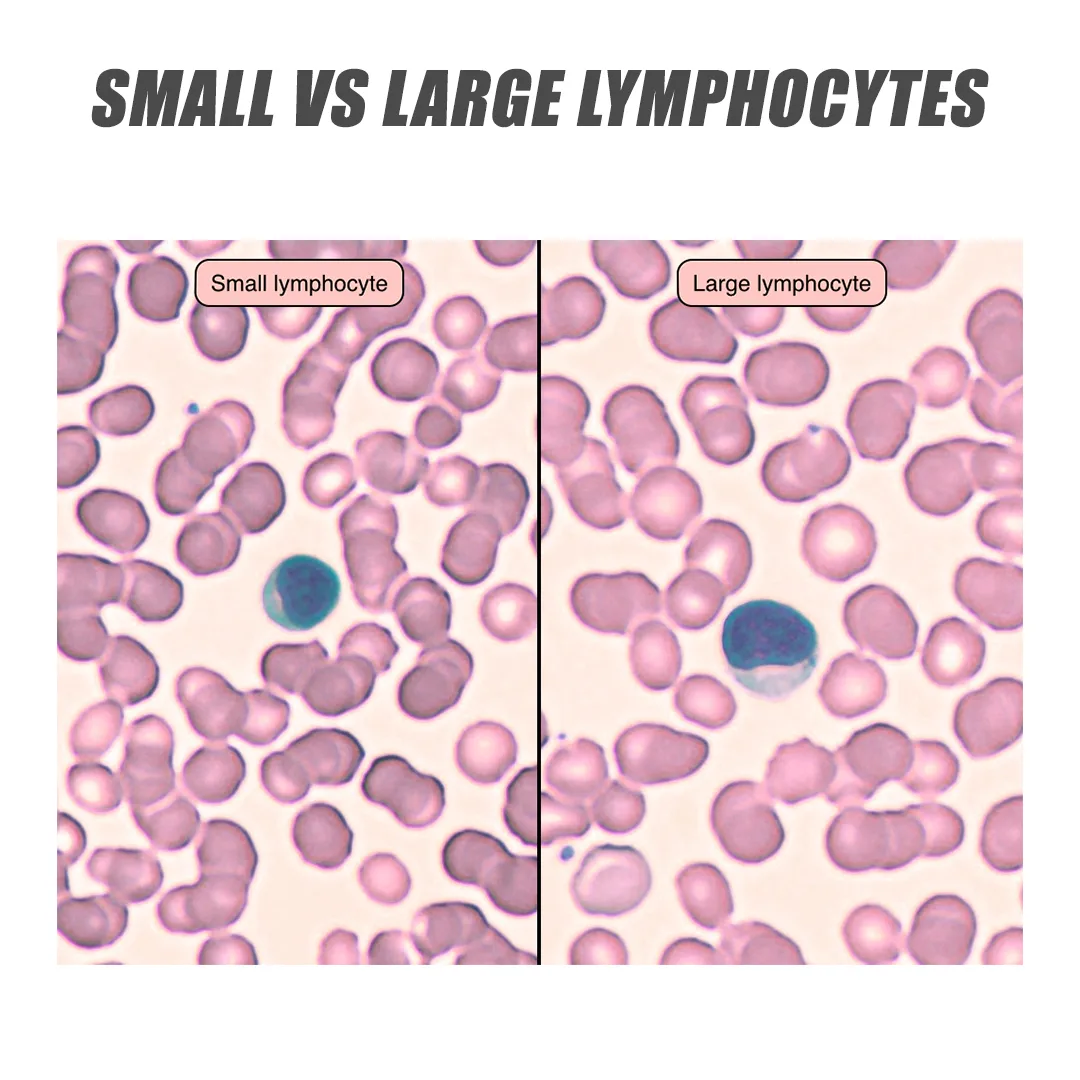
Lymphocytes: Lymphocytes, a type of white blood cell, play a crucial role in the immune system and are present in lymph tissue, blood, and bone marrow. Lymphocytes are immune cells originating in the bone marrow and in blood and lymph tissue. The main types are B lymphocytes, which produce antibodies, and T lymphocytes, which help eliminate tumor cells and regulate immune responses.
These cells are vital for fighting infections, and a temporary increase in lymphocyte count indicates the body's effective immune response. Blood tests are commonly used to measure lymphocyte levels, which require a simple blood draw. Refer to the article below for more detailed information on lymphocyte functions, types, and diagrams. PW NEET Biology Notes are essential for all the NEET aspirants appearing for the NEET exam .Lymphocytes Diagram
Lymphocytes Diagram is as follows:
What are Lymphocytes?
Lymphocytes, a white blood cell found in the blood and lymphatic system, play a crucial role in adaptive or acquired immunity. They are classified as agranulocytes, with B and T lymphocytes comprising approximately 20-25% of total white blood cells. Lymphocytes make up about 99% of the cells in the lymph. There are three main types of lymphocytes: B-lymphocytes, T-lymphocytes, and Natural Killer (NK) cells. Each type has distinct functions and structures. Surface proteins known as cluster of differentiation (CD) markers help differentiate between these subtypes. Lymphocytes are primarily found in lymphoid organs such as the spleen, lymph nodes, and tonsils. They play a key role in initiating immune responses against foreign pathogens. All lymphocytes originate from stem cells in the bone marrow. B-lymphocytes mature in the bone marrow, while T-lymphocytes mature in the thymus. Upon exposure to antigens, B and T lymphocytes differentiate into effector and memory cells. Lymphocytes are responsible for both humoral (antibody-mediated) and cell-mediated immune responses.Lymphocytes Kya Hota Hai
लिम्फोसाइट्स, रक्त और लसीका तंत्र में पाई जाने वाली एक श्वेत रक्त कोशिका, अनुकूली या अर्जित प्रतिरक्षा में महत्वपूर्ण भूमिका निभाती है। लिम्फोसाइट्स के तीन मुख्य प्रकार हैं: बी-लिम्फोसाइट्स, टी-लिम्फोसाइट्स और नेचुरल किलर (एनके) कोशिकाएं। प्रत्येक प्रकार के अलग-अलग कार्य और संरचनाएँ होती हैं। सतही प्रोटीन जिन्हें क्लस्टर ऑफ डिफरेंशिएशन (सीडी) मार्कर के रूप में जाना जाता है, इन उपप्रकारों के बीच अंतर करने में मदद करते हैं।Lymphocytes Percentage
The typical percentage of lymphocytes in your blood falls within the range of 20% to 40% of your total white blood cells. The normal ranges for the various types of white blood cells are as follows:- Neutrophils: 40% to 60%
- Lymphocytes: 20% to 40%
- Monocytes: 2% to 8%
- Eosinophils: 1% to 4%
- Basophils: 0.5% to 1%
Lymphocytes Types
There are two main types of lymphocytes, which are white blood cells involved in the immune response. These are called B lymphocytes (B cells) and T lymphocytes (T cells). Both B cells and T cells originate from stem cells in the bone marrow. Some of these cells travel to the thymus, where they mature into T cells, while others remain in the bone marrow, where they mature into B cells.B Lymphocytes
B cells are named after the bursa of Fabricius, where they were first discovered in birds. In humans and some other mammals, B cells mature primarily in the bone marrow. Mature B cells produce specific antibodies in response to antigens. They bind to antigens using their membrane-bound immunoglobulin or antibody, the B-cell receptor (BCR). Activated B cells can further differentiate into plasma cells or effector cells, which produce large amounts of specific antibodies to fight infections. B lymphocytes trigger the humoral immune response, and memory B cells can remain in the blood for decades, identifying and acting against previously encountered antigens.T Lymphocytes
T cells get their name from the thymus, where they mature. T cells also have surface receptors to recognize antigens but do not directly bind to antigens like B cells. T cell receptors recognize antigens bound to a special kind of cell membrane protein called major histocompatibility complex (MHC) molecules. T lymphocytes differentiate into two main subtypes:- T helper (CD4) cells: These cells recognize antigens with class II MHC and trigger various immune cells (like macrophages, B cells, and cytotoxic T cells) to act against antigens by secreting different types of cytokines, which direct the immune response by other cell types.
- T cytotoxic (CD8) cells: These cells recognize antigens with class I MHC. After activation, they proliferate and differentiate into cytotoxic T lymphocytes, which eliminate virus-infected cells, tumor cells, foreign grafts, etc.
| Other NEET Biology Topics | ||
|---|---|---|
| Ribosomes | Pollination | Apomixis |
| Centrosome | Embryo | Tissues |
| Rhizopus | Pinus | Gluconeogenesis |
| Chlamydomonas | Chara | Ribs |
Natural killer (NK) Cells
NK cells are a third type of lymphocyte that also originate from the bone marrow. NK cells respond quickly to various foreign substances and are specialized in killing cancer cells and virus-infected cells.Lymphocytes Function
Lymphocytes are a type of white blood cell that plays a essential role in the body's immune response. They are produced in the bone marrow and are classified into two main types: B lymphocytes (B cells) and T lymphocytes (T cells). The Functions of Lymphocytes are as follows:- Recognition of Antigens: Lymphocytes are equipped with receptors that allow them to recognize specific antigens, which are molecules found on the surface of pathogens or foreign substances.
- Activation of Immune Response: When lymphocytes encounter antigens, they become activated and start to proliferate, or multiply, to mount an immune response.
- Antibody Production (B cells): B cells are responsible for producing antibodies, which are proteins that bind to antigens and mark them for destruction by other immune cells.
- Cell-Mediated Immunity (T cells): T cells play a key role in cell-mediated immunity, directly attacking and destroying infected or abnormal cells.
- Regulation of Immune Response: Lymphocytes help regulate the immune response by producing cytokines, which are signalling molecules that modulate the activity of other immune cells.
- Memory Response: After an initial encounter with an antigen, some lymphocytes become memory cells. These cells "remember" the antigen and can mount a faster and more effective response upon subsequent exposure.
Sexual Reproduction in Flowering Plants
Lymphocyte Roles in the Immune System
The following are the roles of lymphocytes in the immune system:- Primary Immune Response: Lymphocytes are crucial for initiating the primary immune response against pathogens. B cells produce antibodies, while T cells help in the destruction of infected cells.
- Secondary Immune Response: Memory B and T cells play a critical role in the secondary immune response, which is faster and more robust than the primary response due to the presence of memory cells.
- Immune Surveillance: Lymphocytes constantly patrol the body, scanning for abnormal cells, such as cancer cells, and pathogens.
- Autoimmunity: In some cases, lymphocytes may mistakenly identify healthy cells as foreign and mount an immune response against them, leading to autoimmune diseases.
Lymphocytes Normal Range
The B and T cell screen is a blood test that measures the levels of B and T cells in the bloodstream. The test results can indicate either a normal cell count or an abnormal cell count, which may suggest the presence of a disease. In case of an abnormal count, additional tests may be required to confirm a diagnosis.T Cell Counts
- Above Normal Range: Higher-than-normal T cell counts can indicate conditions such as sexually transmitted infections (STIs) like syphilis, viral infections such as infectious mononucleosis, parasitic infections like toxoplasmosis, tuberculosis, T-cell acute lymphoblastic leukemia, or multiple myeloma.
- Below Normal Range: Lower-than-normal T cell counts can indicate a congenital disease, an acquired T cell deficiency like HIV, or a type of cancer like DiGeorge syndrome.
B Cell Counts
- Above Normal Range: Elevated B cell counts may suggest conditions such as chronic lymphocytic leukemia (CLL), multiple myeloma, or Waldenström macroglobulinemia.
- Below Normal Range: Reduced B cell counts may suggest conditions like B-cell acute lymphoblastic leukemia, HIV, or another immune system-weakening disease like DiGeorge syndrome.
Lymphocytes High Levels (Lymphocytosis)
When there is an increased presence of lymphocytes in the blood, it is referred to as lymphocytosis. This elevation is typically a response to infections or illnesses, where the body produces more lymphocytes to combat the invading pathogens. However, elevated lymphocyte levels can also indicate more serious underlying conditions, such as:- Hepatitis: Inflammation of the liver caused by a viral infection or other factors.
- Syphilis: A sexually transmitted infection caused by the bacterium Treponema pallidum.
- Mononucleosis: Commonly known as "mono," a viral infection caused by the Epstein-Barr virus.
- Tuberculosis: An infectious disease caused by the bacterium Mycobacterium tuberculosis that primarily affects the lungs.
- HIV and AIDS: Infection with the human immunodeficiency virus (HIV) can lead to acquired immunodeficiency syndrome (AIDS), a condition in which the immune system is severely compromised.
- Underactive Thyroid (Hypothyroidism): A condition where the thyroid gland does not produce enough thyroid hormone.
- Infections: Other infections, such as whooping cough, toxoplasmosis, or cytomegalovirus.
- Blood Cancers: Conditions such as lymphoma or leukemia, which involve abnormal production of white blood cells.
Lymphocytes Low Level (Lymphocytopenia)
Conversely, when there is a decreased presence of lymphocytes in the blood, it is termed lymphocytopenia. This reduction can be caused by various factors, including:- HIV or AIDS: The human immunodeficiency virus (HIV) can lead to a decrease in lymphocyte levels.
- Tuberculosis or Typhoid Fever: Infections such as tuberculosis or typhoid fever can result in lymphocytopenia.
- Viral Hepatitis: Inflammation of the liver caused by a viral infection.
- Blood Diseases: Conditions such as Hodgkin's disease, a type of lymphoma, can lead to a decrease in lymphocytes.
- Autoimmune Diseases: Disorders like lupus, where the immune system attacks healthy tissues, can cause lymphocytopenia.
- Rare Inherited Conditions: Genetic disorders such as severe combined immunodeficiency (SCID), ataxia-telangiectasia, DiGeorge syndrome, and Wiskott-Aldrich syndrome can result in low lymphocyte levels.
- Radiation or Chemotherapy Treatments: Therapies used to treat cancer can suppress the immune system and reduce lymphocyte levels.
| NEET Exam Important Links | |
|---|---|
| NEET Biology Syllabus | NEET Biology Diagrams |
| NEET Biology MCQ | NEET Biology Chapter wise Weightage |
| NEET Biology Notes | NEET Previous Year Question papers |
Lymphocytes FAQs
What happens if the lymphocyte count is high?
An elevated lymphocyte count can indicate various conditions, including infections such as bacterial, viral, or other types, blood or lymphatic system cancers and autoimmune diseases causing chronic inflammation.
What does a high or low lymphocyte count indicate?
If your lymphocyte count is higher or lower than the normal range, it may suggest that your body is responding to an infection. It's advisable to consult your healthcare provider for an accurate diagnosis and appropriate treatment.
What is an average lymphocyte count?
In adults, the normal range of lymphocytes is between 1,000 and 4,800 per microliter of blood. In children, the normal range is between 3,000 and 9,500 per microliter of blood.
What is the function of lymphocytes?
Lymphocytes are white blood cells that include T, B, and natural killer cells. They play various roles in the immune system, such as producing antibodies, directly killing virus-infected and tumor cells, and regulating immune responses.
How long does lymphocytosis last?
Lymphocytosis, an increase in lymphocyte count, is typically temporary and resolves within 8 months for most patients. However, some individuals may experience lymphocytosis for more than 12 months.
Talk to a counsellorHave doubts? Our support team will be happy to assist you!

Check out these Related Articles
Free Learning Resources
PW Books
Notes (Class 10-12)
PW Study Materials
Notes (Class 6-9)
Ncert Solutions
Govt Exams
Class 6th to 12th Online Courses
Govt Job Exams Courses
UPSC Coaching
Defence Exam Coaching
Gate Exam Coaching
Other Exams
Know about Physics Wallah
Physics Wallah is an Indian edtech platform that provides accessible & comprehensive learning experiences to students from Class 6th to postgraduate level. We also provide extensive NCERT solutions, sample paper, NEET, JEE Mains, BITSAT previous year papers & more such resources to students. Physics Wallah also caters to over 3.5 million registered students and over 78 lakh+ Youtube subscribers with 4.8 rating on its app.
We Stand Out because
We provide students with intensive courses with India’s qualified & experienced faculties & mentors. PW strives to make the learning experience comprehensive and accessible for students of all sections of society. We believe in empowering every single student who couldn't dream of a good career in engineering and medical field earlier.
Our Key Focus Areas
Physics Wallah's main focus is to make the learning experience as economical as possible for all students. With our affordable courses like Lakshya, Udaan and Arjuna and many others, we have been able to provide a platform for lakhs of aspirants. From providing Chemistry, Maths, Physics formula to giving e-books of eminent authors like RD Sharma, RS Aggarwal and Lakhmir Singh, PW focuses on every single student's need for preparation.
What Makes Us Different
Physics Wallah strives to develop a comprehensive pedagogical structure for students, where they get a state-of-the-art learning experience with study material and resources. Apart from catering students preparing for JEE Mains and NEET, PW also provides study material for each state board like Uttar Pradesh, Bihar, and others
Copyright © 2025 Physicswallah Limited All rights reserved.
Get App









